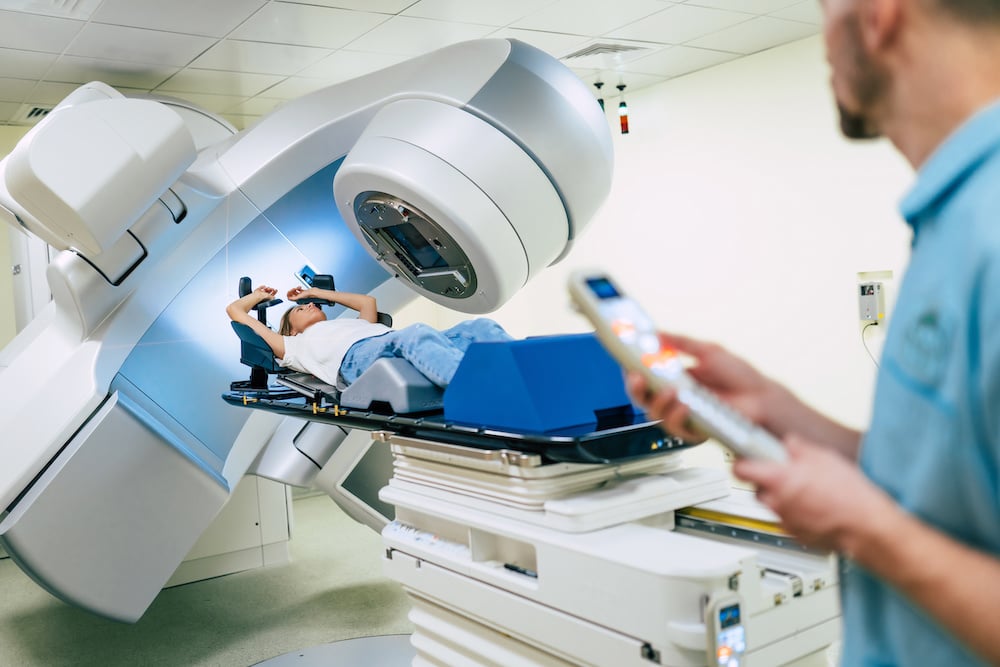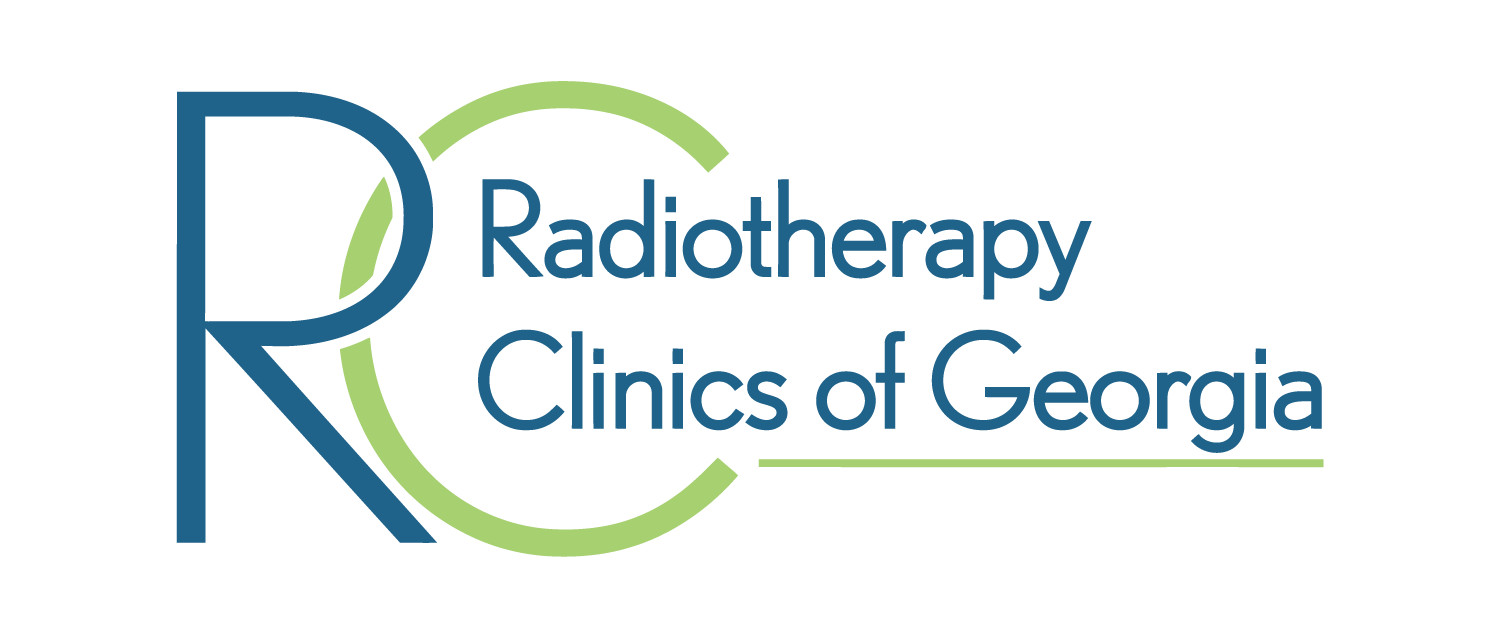
Radiation therapy can be included in an overall lung cancer treatment plan. It is an effective and frequently used treatment method designed to kill cancer cells or keep them from growing without affecting other parts of your body.
Radiation therapy may be used before surgery to help shrink a tumor, making it easier to remove. If you’ve already had surgery, radiation can be used to destroy any remaining cancer cells not removed during surgery. And for patients who are not able to have surgery, radiation may be the only treatment they receive. Radiation is also effective at reducing pain caused by cancer growing in the body.
Understanding when radiation therapy is used and how it’s given will make your lung cancer radiation treatments less stressful.
What Types of Radiation Therapy Are Used for Lung Cancer?
Your treatment plan will include recommendations about the type of radiation delivery method you’ll have. The most common way radiation is delivered to the lungs is through external beam radiation therapy. There are some cases where internal radiation therapy, called brachytherapy, can be used.
External beam radiation therapies for lung cancer
Intensity-Modulated Radiation Therapy (IMRT) is a type of external radiation that includes three-dimensional mapping of the tumor. High energy beams of radiation are delivered into the tumor. IMRT can match the shape and size of the tumor and target it from different angles. It can simultaneously treat different tumors with different doses of radiation. IMRT uses a computer to match the exact shape of the tumors. It minimizes radiation damage to surrounding tissues, and treatment is completed in just a few minutes.
Stereotactic Body Radiation Therapy (SBRT) is another type of external radiation. It may be used instead of surgery in early-stage lung cancer. It’s often used with patients for whom surgery is not an option. It can deliver higher doses of radiation while minimizing damage to surrounding tissue and accounting for small movements from breathing. SBRT uses computers to continuously track the delivery of radiation, and treatment is completed in fewer sessions than other types of external beam radiation therapies.
The actual delivery of radiation therapy is usually painless and quick, lasting 15-30 minutes per session. You may hear the machine click or buzz during treatment or the machine may move around you as you lay very still. Throughout the session, you’ll be able to talk with your radiation therapist.
Most patients have treatments five days a week for three to nine weeks. External radiation therapy has a lower risk of side effects and does not expose others to your radiation, allowing you to continue normal activities during the weeks of treatment.
Internal radiation therapy for lung cancer
When cancer has developed in the bronchial tubes, which are the airways that bring air in and out of your lungs, it may be helpful to use high dose-rate (HDR) brachytherapy to treat the tumor. This process delivers a higher dose of radiation to the tumor without causing as much impact on nearby areas of the body such as the spine, heart, esophagus, or healthy lung tissue.
Brachytherapy usually requires only a few treatments over the course of a few days. A catheter is placed in the airway and then radioactive seeds are placed in the catheter for short periods of time, delivering radiation that shrinks the tumor. The radioactive material is then removed and the process is repeated several more times over the course of a few days.
How Do I Prepare for External Beam Radiation Therapy?
Your treatment will begin with an initial appointment with an oncologist, a doctor who specializes in cancer diagnosis and treatment. The oncologist will review your diagnosis, examine you, and review your medical history. They will also discuss your complete treatment plan with other members of your cancer care team.
During your initial consultation, the potential risks and benefits will be explained, and a preliminary treatment plan will be developed based on your specific needs.
Before external radiation treatments start, you’ll have a simulation session to plan out the actual treatments. Your treatment team will use 3D images to pinpoint the tumor’s location.
Wear comfortable clothes to your treatment planning appointment so you can lie down on the table in the machine that delivers the radiation. While you won’t receive radiation that day, they will need to place you in the exact spot you’ll need to be each time you receive treatments so that it’s concentrated on the area where the cancer is or was. The planning session can be a little uncomfortable because you’ll need to lie on the table for a period of time during the process
Additional CT scans are likely to be taken throughout the process of your daily treatments over the course of 4-8 weeks. This is because the cancer can move slightly in the lungs and they need to be sure they’re targeting the exact location of the cancer.
Will I Have Side Effects from Lung Cancer Radiation Therapy?
While great care and effort is made to target radiation precisely at the tumor, radiation can affect healthy tissue and nearby organs.
Side effects are different for each patient, and some patients don’t notice any serious side effects. You may not notice much of anything until you’ve had several treatments. This is because the damage builds up over time and eventually causes discomfort.
Short-term radiation therapy side effects include:
- Lung damage that can cause a dry cough and shortness of breath
- Fatigue, or feeling very tired
- Nausea or vomiting
- Sore throat or difficulty swallowing can be caused by damage to the windpipe
- Dry mouth or mouth sores
- Loss of appetite
- Diarrhea or constipation
- Skin problems – pain, redness, peeling or dryness over the radiation site
- Hair loss at the area that’s receiving radiation
- Anxiety or depression
Your cancer care team needs to know how your body is reacting to treatment. Always report any side effects immediately to your oncologist. He/she can advise you about ways to lessen side effects. Most side effects end within a few months after treatment ends. However, long-term side effects can be serious and require monitoring.
Tips for Coping With Side Effects
These coping strategies can help with side effects.
- To lessen fatigue, get plenty of rest and try short naps during the day. Get gentle but regular exercise most days of the week. Eat healthy foods and plenty of protein. Ask others to help you with strenuous activities such as cleaning or shopping.
- If you develop skin reactions, wash your skin gently with your hands instead of a cloth. Use moisturizing products with lanolin or aloe. Never use skin products right before a radiation treatment. Avoid the sun; cover your skin when outside. Try an electric shaver instead of a razor.
- Be gentle on your throat by eating soft, moist, and bland foods. Avoid spicy, hard, and greasy foods. Suck on hard candy or a popsicle. Ease mouth sores and clean your mouth by gargling one teaspoon of salt or baking soda dissolved in one cup of warm water.
- Eating more frequent but smaller meals will help with gastrointestinal issues. Peppermint or ginger tea can lessen nausea. Ask your doctor about medications to reduce nausea. Drink plenty of water between meals if you’re having diarrhea.
- Depression and anxiety are helped by physical exercise, deep breathing and relaxation techniques. Call your doctor immediately if you have suicidal thoughts. Ask for a referral to a mental health professional. Spend time with family and friends. Talk with them about your feelings.
- Ask for a palliative care referral. Palliative care is designed to lessen your pain and help you cope with all of the side effects of cancer treatments.
Will I Need Monitoring and Follow-Up Care After Treatment?
When your radiation treatment plan is complete, it’s very important to continue your follow-up care. Never miss any of your follow-up appointments with your radiation oncologist or medical oncologist. They need to monitor your recovery, check for cancer recurrence, watch for delayed side effects, and may recommend post-treatment scans or blood tests.
If you have radiation therapy as part of your lung cancer treatment plan, you can choose where you receive your care. Choosing a location close to your home or work can be beneficial and convenient for you. Our cancer centers are located in Conyers, Covington, Decatur, and Snellville, Georgia.




